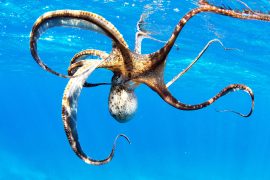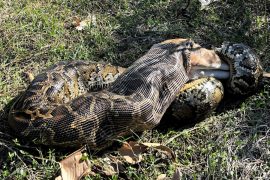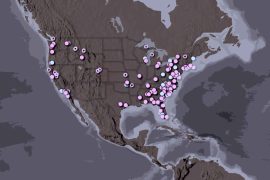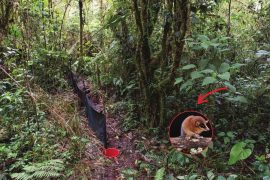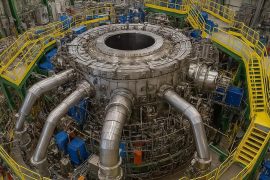
Explaining Watersheds with 9 Examples
Have you heard the term ‘watershed’ but never actually had it explained to you? Fortunately, explaining a watershed is pretty easy, and the importance of watersheds can’t really be overstated. Here, I’ll try to explain watersheds using interesting examples and stories from around the world.
Before we dive in, the definition of a watershed on the National Oceanic and Atmospheric Administration’s website is “a land area that channels rainfall and snowmelt to creeks, streams, and rivers, and eventually to outflow points such as reservoirs, bays, and the ocean.”
Explaining Watershed Basics

A map of the Amazon River watershed. The area highlighted in yellow all drains towards the Amazon River. Thus, that is the Amazon watershed. Map by Karl Musser via Wikimedia
1. The Amazon River Versus Your Local Stream – Watersheds Come In All Sizes
The Amazon watershed is the largest in the world, spanning some four million square kilometers. The map above shows all of the lands that drain into the Amazon River. The water in the Amazon River comes from Bolivia, Peru, Ecuador, Colombia, Venezuela, and Brazil. All of these countries are part of the Amazon watershed.
The large rivers that feed directly into the Amazon, such as the Madeira and the Negro, are major tributaries to the Amazon. The Cassiquiare (highlighted in purple) is a minor tributary. Each of these smaller rivers has its own watershed, which is nested within the Amazon watershed.
As opposed to the Amazon, watersheds can also be small, such as an alpine mountain bowl. Since the water in the mountain bowl will connect with another stream in a short distance, that one alpine bowl is the entire watershed for that stream. Sometimes you can see an entire watershed at once if you are in the right place and it is a small watershed.
As a side note, watershed maps can make some pretty stunning visuals.

A map of the continental divides in North America. Triple Divide Peak is where the green and red lines intersect. Map by National Atlas of the U.S. via Wikimedia
2. Triple Divide Peak – The Concept of Continental Divides
A continental divide is a high point that determines where water goes. If water falls on the left side of the Great Divide (red line) it flows to the Pacific Ocean. If it falls on the right side, it goes to the Gulf of Mexico.
Triple Divide Peak in Glacier National Park is a very interesting place with regards to watersheds. The peak is where the green and red lines meet on the map. Instead of a normal divide, this peak is the intersection of two continental divides. This means that a storm that hits Triple Divide Peak will send water to the Pacific Ocean, Gulf of Mexico, and the Arctic Ocean all at once! That same storm will send water to the swamps of Louisiana and the icebergs of Canada.
Continental Divides are the largest of divides, but any ridge that separates two watersheds is considered a divide. As with watersheds, divides can be huge or small.

An example of a watershed meeting the ocean in arctic Alaska. Photo by the author.
3. Tracking Pollution – How Tributaries Work
A watershed is made up of many tributaries, as described above. Imagine researchers in New Orleans (the end of the Mississippi watershed) noticed new oil pollution occurring in the Mississippi River. They can track down the source of that pollution by working backstream up to the source of oil pollution.
Since smaller tributaries flow into larger ones, the concentration of oil in the tributaries closer to the oil pollution will be higher. As the oil flows away from the pollution source, it gets diluted.
Say the researchers work upstream and get to the confluence (meeting point) of the Mississippi and Arkansas rivers. They notice most of the oil is coming from the Arkansas River, a major tributary of the Mississippi, so they work up that river until they find the next tributary contributing large amounts of oil. As they work up the tributaries, the concentration of oil in the water will increase and the researchers will likely find the culprits of the pollution. This is one way to find polluters using a watershed. It also demonstrates how tributaries work.
In a real-world example, in the Alaskan arctic, increasing wildfires due to climate change have altered the composition of rivers. The rivers now contain more carbon and nitrogen from ash due to the fires than they previously did.
4. The Unpredictable Colorado River – Watersheds Change Throughout the Year
Before humans put a series of dams on it, the Colorado River was the most dynamic river in the world. The Colorado River is fed primarily by Colorado, Wyoming, and Utah. Much of the flow comes from melting winter snowpack in those states. When almost all of the snow has melted in the late summer, there is very little water feeding the river.
Historically, the Colorado River, which drains about 1/12th of the continental U.S., could run as little more than a small stream in the deep summer of a dry year. Conversely, on a big snow year, and with strong summer monsoons, the Colorado River could reach 500,00 cubic feet per second (cfs), pushing nearly as much water as the Mississippi. By contrast, the historical annual average for the river is about 22,500 cfs. This shows that rivers can change dramatically based on what happens in their watersheds.
5. The Great Basin – Sometimes Watersheds Don’t Reach the Ocean
The Great Basin covers almost all of Nevada and some of its surrounding states (see in the continental divide map above). This area is defined by being an endorheic basin, which means that none of the rain or snow that falls within the basin makes it to the ocean.
Instead of a normal watershed that flows to the ocean, the Great Basin is like an enormous bowl. All precipitation that falls above the bowl drains to the bottom of the bowl. All the precipitation that falls outside the bowl makes it to the Pacific Ocean. In this analogy, the rim of the bowl represents the continental divide between the Great Basin and the Pacific Ocean.
You may be wondering “if the water doesn’t drain out to the ocean, where does it go?”
In some cases, it collects in lakes, such as Pyramid Lake, Lake Tahoe, or Great Salt Lake. In other cases, it simply drains down into the earth through cracks in the rocks. Over millions of years, water that seeps through the rocks creates an aquifer. An aquifer is a massive underground reservoir of water.
While the idea of an endorheic basin might seem unlikely, they actually cover 20% of the Earth’s land area. Most of the interior of Asia is actually an endorheic basin!

These lakes flow into the valley far off. The valley is an endorheic basin, meaning the water doesn’t flow to the ocean. Rather, it seeps belowground into an aquifer. Photo by the author.
Explaining Watersheds and the Environment
5. Salmon Runs in the Elwha – Watersheds Indicate Environmental Health
As noted above with the pollution example, watersheds can tell us valuable information about our landscapes. Take the Elwha River in Olympic National Park, for example. In 2011, the national park began the largest dam removal in history. They took down two dams on the Elwah River, which had blocked salmon from spawning upstream for nearly 100 years.
From the perspective of a salmon, a watershed with lots of dams is not a good watershed. While salmon are impressive jumpers, they can’t jump over dams 100 feet high. Since they need to head upriver to lay eggs, dams around the world prevent salmon from reproducing.
However, just a few years after the Elwah dams disappeared, the salmon came back in force. In the years since the removal, steady salmon runs have developed on the Elwah River.
The Elwah watershed is almost entirely within the national park, meaning it doesn’t have many other environmental pressures such as human development or pollution. So when the dams came down, there was little preventing the salmon from recolonizing their historical homes.
This example of watershed restoration shows how the watershed’s health can be an indication of an entire ecosystem’s health. Since the Olympics are relatively pristine, the salmon easily retook their habitat. However, if humans took dams down along a heavily polluted river with many major cities on it, it would be harder for the salmon to retake.

The Colorado River in the Grand Canyon. Photo by the author.
6. The Colorado Pikeminnow – A Species That Exists in Just One Watershed
Imagine you are a fish in a river. It would be pretty difficult to move to a different river altogether, right? Watersheds often have fish, amphibians, and insects that are unique to that river system for precisely this reason.
The Colorado pikeminnow is an example of this specialization. Living only in the Colorado River, this fish is a minnow that grows up to six feet long! If you think this is strange, well, it is. Minnows are generally small. However, this minnow was isolated from other watersheds for so long that it changed into something completely different – the top predator of an entire river system! Watersheds can determine the evolutionary fate of species such as the Colorado pikeminnow.
Unfortunately, all the dams, human development, and invasive species in the Colorado River, the pikeminnow is a federally endangered species.
7. Airsheds and Foodsheds – The Concept of Watersheds Broadens
Now that we have explained watersheds, perhaps we should explore other ‘sheds.’
Airsheds are defined by regions that share the same air quality. If a coal-fired powerplant is in your airshed, it will pollute your air, just as if someone dumped pollution upstream in your watershed, it would impact you downstream. Unlike watersheds, which always have movement from upstream to downstream, the movement in an airshed changes depending on the season, weather, and climate of that airshed.
Foodsheds are less geographically determined than airsheds and watersheds and are created more by humans. A foodshed is a geographic area that grows food for consumers in that area. Foodsheds are a central concept to the local food movement.

All of the fresh snow is part of this watershed. The snow will melt into the river, which drains to the ocean. Photo by the author.
Explaining Watersheds and How they Relate to the Law
8. The California Aquaduct – Watersheds Create Fights
“Whiskey is for drinking, water is for fighting” is a common phrase heard around the West. And it’s true. The western U.S. is severely prone to droughts, which are worsened by climate change. As a result, places like Arizona and southern California have used all of their natural water. To overcome their lack of water, western states have engaged in feats of great engineering involving pumps, aqueducts, tunnels, and dams. Some aqueducts move water from one watershed to another, through mountains and across plains.
The California aqueduct is one such aqueduct. It moves water that originates in far northern California and pumps it as far south as L.A. The water crosses multiple watersheds in a completely unnatural system. Literal cubic miles of water are pushed up thousands of feet to make it from north to south, requiring tremendous amounts of energy.
While some in California see this distribution of water as equitable, others say its wrong to move water outside of its original watershed.
Legal questions regarding how water can be distributed are ongoing. In Nevada, it is illegal to move water from one basin to another. However, Las Vegas has tried for 30 years to do just that. After seven failed lawsuits, the Southern Nevada Water Authority gave up the potential project, which would pump an aquifer in the northeast of the state and bring it to Las Vegas through a pipeline.
9. The Whanganui River is a Legal Person – Watersheds Gain Rights
Some environmental lawyers and indigenous groups have found success in getting watersheds the rights of a legal person. The first such case was in New Zealand, where the Whanganui River gained rights in 2017. This means that lawyers sue on behalf of the river, charging that activities such as pollution or development harm the natural state of the river and that actions must be taken to restore that natural state.
While it may seem bizarre to categorize a river as a ‘legal person,’ it isn’t so unusual. Corporations are legal people in the U.S., enjoying more rights than almost all animals and natural places. Many environmental lawyers believe that watersheds deserve that same personhood.
The Yurok tribe in northern California followed suit a few years after New Zealand and succeeded in getting the Klamath River designated as a legal person. This includes all of the tributaries within the watershed of the Klamath. This case is particularly interesting because a larger dam removal project than that on the Elwah will occur on the Klamath in the next few years.
I encourage you to learn more about your own watershed. We all have one and we would all benefit by knowing a little more about the resources that give us life.
—–
Like what you read? Subscribe to our newsletter for engaging articles, exclusive content, and the latest updates.
—–
Check us out on EarthSnap, a free app brought to you by Eric Ralls and Earth.com.
—–
News coming your way


